#Whether you see the 2012 turtles as black or Asian
Text
This is literally 2012 human Leo

Just look at her



She slay
Is from a Netflix series called Blue Eye Samurai if you want to sheck out
#Whether you see the 2012 turtles as black or Asian#you can't deny that they look alike#she gives the same vibes#tmnt#transfem leo#teenage mutant ninja turtles#blue eye samurai#leona artemis hamato#2012 leo#tmnt 2012#tmnt leo
224 notes
·
View notes
Text
FibS lays down the facts: April o' Neil
I'm so fuggin' tired of hearing morons drool out their mouths over this so here's all you need to know:
It's perfectly fine that Rise April is black.
April o'Neil has been portrayed as black before Rise.
April o'Neil was not "originally black" in the Mirage comics.
Rise did not make April black for woke points. Rise makes numerous changes to Turtles orthodoxy so that it isn't a boring repeat of the more traditional 2012 cartoon that immediately preceded it.
(EDIT: Many of the comic scans from this blog post, as well as some of its information, are from this blogspot post from 2018. I neglected to mention this earlier, but at least one person is asking. Unfortunately, people who reblog this post from earlier versions will not see this edit.)
The original creators of TMNT are Peter Laird and Kevin Eastman. Laird has always considered April o'Neil to be white other than considering possibly making her Asian in early notes; the confusion over April's race is solely due to Eastman.
In her earliest appearances, April o'Neil conveniently stands right next to known definitely-black character Baxter Stockman:
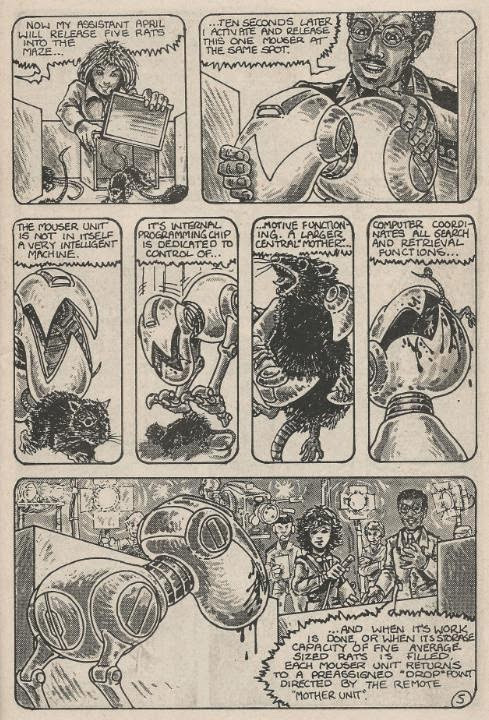
This April is as white as the Mousers and the lab walls and doesn't have curly hair. If anything she looks like Sigourney Weaver (Dutch, English, Scots-Irish, Scottish), right down to Ellen Ripley's outfit.
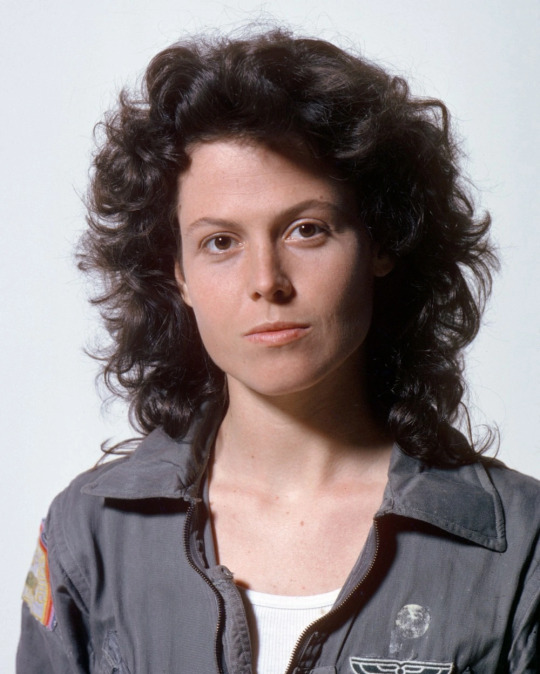
Since Alien came out in 1979 and Ellen Ripley is a massive influence on female lead characters even decades later, this resemblance might be intentional.
But Kevin Eastman, who has a habit of designing female characters based on the woman he is seeing at the time, redesigned April two issues or so later based (rather loosely) on his at-the-time girlfriend April Fisher (she has since passed away.)
April Fisher was, as a matter of fact, mixed-race.

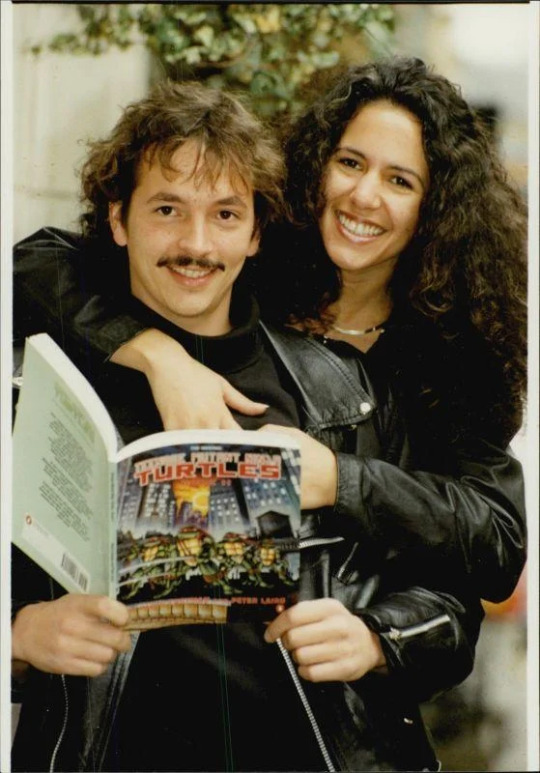
Eastman later clarified that April Fisher was, of course, the source of April o'Neil's given name the entire time. (And I would like to point out that the surname of o'Neil doesn't preclude someone from being black.)
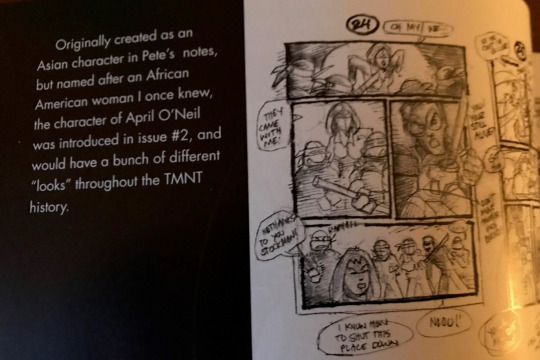
But being named after or inspired by a mixed-race person the creator knows does not mean the character is mixed-race, any more than the numerous My Little Ponies based on real people share those people's races (as opposed to being cartoon horse fairies or whatnot.)
April o'Neil specifically states that she got her hair done. That is to say, she got a perm.
Since black women's hair is already very curly, black women get perms to straighten their hair. April got hers to curl her hair - because she's not black, she's a white lady trying to look like a bootleg Paula Abdul (Syrian).

Or, quite frankly, any other 1980s pop star?
Because, y'see, now's a great time to point something out that Twitter & Tumblr seem to hope you'll forget:
The entire 1980s.
I'm pretty sure nobody who cares whether April o'Neil is black or not knows who Paula Abdul is, except maybe that she was a judge on American Idol. Paula herself might be a year or two late for April's redesign to reference her specifically, but April o'Neil looks like any random white woman from the 1980s. Because the Mirage comics were released in the 1980s. They take place in 1980s New York. And damn near every single white woman in the 1980s got a perm at some time or another.
I doubt these black April fanatics recognize half of them:


.....
Even the men got them!!

And eventually, around the time everybody else was over it, the exact same April o'Neil in the exact same continuity lost the perm:

Remember what Eastman said about April's "different looks"? Even in the same damn comic they can't draw her consistently. April here not only looks nothing like Paula Abdul April, but nothing like Ellen Ripley April either. Hell, she looks like a JoJo character.

And there are some panels were Paula Abdul April is shaded darker than in others, which you could take as April being black if you literally ignore the entire rest of the comic and pretend that's the only time she was ever drawn:

You know, like how people pretend Princess Daisy was "originally black" because she was sliiiightly darker in Mario Tennis than usualy, including ignoring that there are earlier illustrations where she is more pale?
A perm and a tan doesn't make you black. That'd be, y'know, blackface. Not like T&T actually knows what that means either, since they think a white person posting an image with a black person in it counts as it.
Don't you think the fact April looks like four different people in the same fucking comic should convince us that we can't deduce her race from interpreting the illustrations and instead, we should, I dunno, recognize that every single time April has appeared in color with Laird and Eastman's oversight, she's been clearly white?
As opposed to that one comic everybody likes to cite, which is a non-canon guest comic by Mark Bode that changes such details as the city it takes place in and April's job, which was originally published in black and white, whose black April was colored that way by another guest artist (Bill Fitts) and looks like a disco queen stereotype which I could've sworn T&T hated, and which was later corrected to a white April when republished:

We really shouldn't listen to uneducated narcissists who want to have their cake and eat it too, don't know who Cyndi Lauper is, and already had their conclusion ready before they looked at any of the evidence, blatantly misinforming us about the world's most inconsistent comic and pretending 98% of that comic and one of the most important decades in modern human culture just never fucking happened.
20 notes
·
View notes
Text
[Pedro Neves Marques:] You already mentioned science, but do you mind going back and talking a little bit more about the notion of “Indigenous science and sustainability”?
[Grace Dillon:] Nowadays, I think in terms of Indigenous sciences rather than science. I feel that’s the way we should think about all sciences, as plural, whether we label them Westernized, Indigenous, or whatever form they may take. Let me quote from Gregory A. Cajete, a member of the Santa Clara Pueblo Nation who has worked in the field of Native science or sciences. He asks, “What is Indigenous science?” According to him, “It is knowing how to live in a place sustainably.” [...] What I love about current Indigenous Futurisms and how they’re changing is that they aren’t constrained by this binary between Western science and Indigenous or non-Western science. One example is Nalo Hopkinson’s novel The New Moon’s Arms (2007), set in the Caribbean. There’s this scene close to the end of the book, after the characters have suffered all of this environmental and extractivist injustice, where the grandmother is passing on her traditional ways of knowledge to her grandson but, since he goes to school, they’re actually teaching each other. “Intergenerational” doesn’t imply a hierarchical, top-down elders’ passing of knowledge only. It’s more of an exchange of ideas. This is what I see going on between generations in our Indigenous communities right now. In the science fiction field, my goal is to quietly change the mission for the top-notch journals in the field that are still simply clinging to stories about advanced technology and this linear way of thinking about knowledge as mere accumulation. [...]
-------
[PNM]: In Brazil, the word that the postwar fascist regime used for clearing certain areas of the country to allow for so-called development was “pacification,” which was applied to both Native peoples and the landscape. Instead of saying that they would cut down a forested region or displace and “educate” its local Native communities, they’d call the whole process “pacification.” So that’s become an extremely loaded word in the Portuguese language. Beyond the term’s historical associations with the military fascist regime, it reinforces the colonial notion that equates Native peoples with “nature” and a violent wildness, like the threatening woods that you just mentioned. Going back to your ideas, it’s been almost a decade since your anthology Walking in the Clouds was published. And what a decade it was! We saw an intense transformation in the field of science fiction, with a wave of Indigenous, black, Asian, and many other nonwhite authors, [...] being published and offering some of the decade’s most challenging stories. [...] Do you find that multispecies entanglements and the inclusion of nonhuman beings has also grown in visibility, within and outside these stories? I’m asking this because, for instance, in Brazil, debates about the rights of nonhuman or other-than-human beings have been key to Indigenous [...] discussions for at least the past two decades. There, the debate mostly centers around plant or animal persons, and moreover the [...] question of “what is human,” from an Indigenous point of view. That is, the knowledge that terms like “animal,” “plant,” “human,” and “spirit” may mean something much broader than how modern sciences define them.
[GD:] Back in 2012, I was talking about animal persons, rock persons, phenomenological persons, plant persons, and so on, and you could sense a quiet skepticism among some people. They would see it as a form of animism, when in fact I was talking about sciences. For example, plants literally converse among each other; plants that live in toxic areas warn other plants to stay away. There are many examples of nonhuman persons in fiction about sciences. Take Thomas King’s novel The Back of the Turtle (2014), a story about a First Nation scientist who is developing chemicals for a bioengineering company that is truly extractivist and toxic, until he sees how that’s impacting the land, together with its animal and plant persons, and he is thrown into a crisis. Does he want to be a scientist? Or at least a scientist in that kind of context?
-------
[PNM:] How do you see the relation between science fictions and Native myths and mythology? While the modern mind may eventually recognize the cultural value of Indigenous myths, it refuses to see them as scientific evidence. I wouldn’t want to project a meaning onto these stories, so I say this very carefully, but although in Brazil you may not find a great presence of Indigenous science fiction, Native traditions and myths almost seem to perform science-fictionally, in how they both rupture modern categories and expectations and allow for imagination beyond colonial frameworks.
[GD:] I have a lot to say about this. The first thing I’d like to do is to eradicate the term “myth” or “mythology,” because that implies that these stories are false or that they are fictions that should be questioned. Instead, what I do -- and this is what I grew up with -- is to call them “stories.” Everything is storytelling. Indigenous sciences are embedded in stories; this is how we share our Indigenous sciences. I grew up in an [...] anarchist community that was Anishinaabe-founded, at least to some degree. So, when I read Ursula K. Le Guin’s 1974 novel The Dispossessed, I could absolutely understand the whole process of community and of shunning or shaming a person as a form of power and control, but also the recognition of combining art with science, rather than understanding them as separate. Although her story is science fictional, by acknowledging the role of storytelling in this combination between art and science, Le Guin again takes the fiction out of science fiction, and works with other forms of science. Our word aadizookaanan means “ceremonial stories” or “sacred stories.” Most First Nations don’t share those sacred stories with outsiders. However, in 2012 many of the nations I belong to -- and you should know that we Nish peoples are often called the pacifist-anarchists among other Indigenous nations -- got together and decided to share not only our gikendaasowin, meaning herbal knowledge and science and how they interact with ceremonies and songs, but also our aadizookaanan. We decided that some of our sacred stories needed to be shared globally, because they were necessary right now for dealing with Mizzu-Kummik-Quae, Mother Earth. So the reason I’m interested in science fiction is that when I was little and we had firesides, sweats, and other ceremonies, we were telling stories about star peoples that came to earth in, basically, space canoes. For me, the concept of a spaceship was not unusual. And, of course, we are all star people. We are made of stardust, which is scientifically accurate. Everything is made of stardust.
-------
Grace Dillon and Pedro Neves Marques. “Taking the Fiction Out of Science Fiction: A Conversation about Indigenous Futurisms.” e-flux. September 2021.
607 notes
·
View notes
Text
Why I (Want to) Love Rise of the Teenage Mutant Ninja Turtles
Salutations, random people on the internet who most certainly won’t read this! I’m an Ordinary Schmuck. I write stories and reviews and draw comics and cartoons. I also LOVE the Teenage Mutant Ninja Turtles.
Whether as a kid, or an adult pretending to be a kid, this franchise is one that I’ll always revisit no matter how old I get. So when I heard that a new version of the series was coming out in 2018, titled as Rise of the Teenage Mutant Ninja Turtles, I was excited about it. Then I watched the series...and most of that excitement went down the sewer drain.
Don’t get me wrong, there were some elements that seemed like there was some definite promise for a good series, but other aspects...I’ll have to explain.
But keep in mind, I am going to be spoiling a lot about the series. So if you haven't watched it yet, I highly recommend you do so to form your own opinions. Because while it may not have grabbed me as much, that doesn’t mean the same can’t be said for you. With that out of the way, let's get started with--
WHAT I LIKE
The Animation: If anybody ever tells you that Rise of the Teenage Mutant Ninja Turtles has awful animation, they are objectively wrong. Rise of the TMNT has some of the best, if not the best, animated fight scenes I've seen from any action series in recent memory. Probably because the show understands the number one rule of action animation: Good animation is a requirement. Not an exception.
For an action-oriented animated series, the audience needs to feel the impact whenever characters punch, block, or dodge in each fight. Yes, even dodge. Because if you can feel even the tiniest gust of wind that passes by a character's face after a punch, then you know the animators are doing something right. And trust me when I say that is present in the majority of most fights in Rise of the Teenage Mutant Ninja Turtles. Are there moments when the movements are slow and rigid? Yes...during the dialogue and comedic scenes. Moments where good and quality animation isn't really all that necessary. You see this same technique in most modern anime: The animation is rigid and cheap for the dialogue-heavy scenes so the animators can give extra attention to the epic action set pieces. Not a single person complains about this happening in their favorite anime of the week. But when Rise of the Teenage Mutant Ninja Turtles does this, apparently it's a bad thing? Explain that logic to me!
The animation is phenomenal in this show. Don't let anybody tell you otherwise because those people are either blind or insanely stupid. Either works.
It’s Pretty Funny: And that's about it. It's nowhere near one of the funniest shows I have seen, and previous iterations of the franchise did a much better job at balancing humor and heart, but Rise of the Teenage Mutant Ninja Turtles did a great job at getting a laugh out of me from time to time. It has a very random sense of humor that works well with its manic energy, similar to what Star vs. the Forces of Evil did early on in its first season. Even if one joke fails, about ten more take its place, most of them funnier than the others. There may be an occasional issue where a joke spoils a dramatic moment, but Rise of the TMNT is one of the few shows where that issue doesn't happen often. Besides, the series sets itself up as more of a comedy than other reboots and reiterations, so it wouldn't look good if it wasn't funny. Thankfully, it is, and in a way, the show is a success because of it.
It Tries to be Something New: This is what I respect most about the series. The downside about a reboot is that writers have to find a way to tell the same story but with adjustments that make it seem different. That's the same way Teenage Mutant Ninja Turtles operates as a franchise. The original concepts of the stories and characters are always iconic, and I'll love them with my whole heart, but I will admit, there's a point where the same thing over and over again can be a little tiring. Then there's Rise of the Teenage Mutant Ninja Turtles, which makes changes where other shows would ask "why," this is the one that asks "why not?"
Why not change the personality and backstories of characters that still fit with the spirit of the original?
Why not change the genders, races, and possibly sexualities of these iconic characters?
Why not make something new?
Now, some have argued that the show is a little too new. Which I can kind of see the point of. After all, what's the point of changing characters and concepts so drastically when you could just make an original series? But even then, most of the changes are pretty clever, that I think it’s worth remembering for future iterations. Like making Casey Jones a female. Casey is a gender-neutral name, and I legitimately thought this series would do it for that reason alone. So I feel bad that the writers never got a chance to allow the series to reach its full potential with ideas like this due to Nickelodeon screwing them over (Seriously, never pitch a show to Nickelodeon. It rarely ever works out, and it's not worth the risk). I can see how these ideas could result in an incredible show that might cement the series as one of the best iterations of the franchise. But I can't base a story on potential. I can only judge what I see, and what I see are brilliant changes that impress me from time to time.
The Creators Are Still Fans: Despite making something completely different, you can tell that everyone working on this show loves TMNT as the rest of the fans do. There are dozens of references to previous versions littered throughout the series. Whether it's shoutouts to the 90s cartoon to bringing back voice actors from the last one, there are moments where the crew behind the series emphasizes how much they care about the franchise. There are also times when a reference has such a deep cut to it. For example, the series has the previous VA for Splinter to voice the current version of Shredder. I shouldn't have to explain how that is a brilliant idea, especially given Shredder's relationship with Karai...which I can't fully explain due to it spoiling TMNT (2012). This might be a whole new experience, but it is clear that history is not ignored when it comes to Rise of the Teenage Mutant Ninja Turtles.
The Cast is Colorful: It's not precisely a diversity win to have half the Turtles voiced by black VAs, but it is unquestionably some good sign of progress. The Teenage Mutant Ninja Turtles are...accurately what they are called. So they are not defined by the skin tone of the VAs themselves. So having half of them be voiced by people of color makes me hopeful that maybe future reboots would consider more colorful castings. Hell, maybe one day we'll have a Teenage Mutant Ninja Turtles reboot where all of them are POCs, to the point that we'll have an all-Asian casting for these timeless heroes (which makes way too much sense to me).
And it's not just the casting of the turtles that impresses me. Because the series making April O'neil black is an idea that I'm more than ok with. It's implied that she's black in the original comics by Keven Eastman and Peter Laird, so it works as another deep-cut reference that proves how big of fans the crew is. Plus, who cares? I mean, if we're still having issues of changing the race of a character who was originally white, all I can say is grow the hell up. You can complain if they don't grab you, but if the issue is because of one decision that shouldn't negatively affect anybody, I don't see the problem. Besides, at this point, a character being white is basically the base plate for someone in the future to change their race at another time.
Also, let’s give the people behind the casting a pat on the back for casting Asian VAs for characters who are, well, Asian. It’s the bare minimum of common courtesy and avoids the trouble of having white VAs do asian accents that have become quite culturally insensitive nowadays. So it’s a pretty cool decision if you ask me.
Diversity is never an issue, especially since representation always matters for people who demand to be heard. It's definitive proof that anybody can be anything, whether it's a hero in fiction or the voice of that hero behind the scenes. And you can't really do that when everyone is so white that it's blinding.
Donatello: This is the best character in the series. Not only because Donatello has the most consistent personality (more on that later), but also because I'm a sucker for the cynical super-geniuses. These types of characters always have a quick and dry wit that never fails to get a laugh out of me, and this version of Donatello became my favorite just for that factor alone. Most of the credit goes to Josh Brener, who does a phenomenal job at his performance and comedic delivery. As for the emotional bits, he's...fine, but the drama isn't the show's best strength anyway, so it doesn't matter as much. Because the fact that it's Donatello who earns the spot as best character in a Teenage Mutant Ninja Turtles reboot is an impressive feat in itself that any criticism offered for him is moot in the process.
WHAT I DISLIKE
Leonardo: I'm willing to make half of this a personal issue because I have grown to despise Ben Schwarts in the last four years. No offense to the guy, I'm sure he's a really great person in real life...but he has done nothing but play the same character in FOURS YEARS! Whether he's Leonardo, Dewey Duck, Sonic the Hedgehog, or even M.O.D.O.K.'s son (yes, that's a thing), Ben Schwarts has practically played the exact same character each time. The highly energized, dimwitted, and egotistical character who slowly tries to learn to be a better person in the end. AND SOMETIMES, NOT EVEN THAT! I'm sick of it, as it always breaks the immersion of the series as all I hear is Ben Schwarts and not the character he's voicing. But it's not just the voice behind Leonardo that frustrates me. Because the thing is, I can see how this version of him can be incredible.
It doesn't take a genius to know that this version of Leonardo is meant to be more childlike and carefree so he can morph into the more mature leader we all know and respect him as. The issue is that the writers barely do anything with that idea. Sure some episodes make this Leonardo more like, well, Leonardo, but they're far and few between the ones where he's the same Ben Schwarts character that I've grown to hate. Even when he is at his most Leo-like, as seen in the episode "Man vs. Sewer," it's so drastically different from how he usually acts that it feels less like character development and more like inconsistency. It's a shame too because I really love this idea. With a little more polish, it could work out. As is, it's just a huge chunk of wasted potential.
Raph’s Too Good of a Leader: This is a similar issue to what I've mentioned about Leonardo. Because, again, I love this idea. Raphael, in multiple iterations, complained about how he should be the leader and just as frequently learns why the job rightly belongs to Leo instead. So starting with this role reversal should be a well-executed idea that gives Raph what he wants while eventually giving the fans what they want. And it would be if not for the fact that Raph seems to be too good at his job.
I get it. If Raphael was too incompetent, the turtles would have gotten nothing done, and it would get too tiring too quick as Leonardo constantly proves why he should lead and why Raph should follow. This actually happens from time to time, and it is already tiresom. The issue is that the intention was to make Leonardo the leader in the end. So why spend so much time showing how Raphael is capable at the job and barely any time showing why Leonardo is a better fit? There are even times when Raphael seems like he really is a better leader than Leo, which I feel as though it is contradictory to the point the writers are trying to get across. In the end, it's nothing more than another really great idea met with insanely poor execution.
Master Splinter (Early Season One): ...Did anybody like this version of Master Splinter in the first half of season one? Because this character was atrocious, especially compared to the previous Splinter from TMNT (2012). We went from what is easily the best interpretation of the character to what was, at the time, the worst. He was lazy, selfish, and emotionally distant with his sons to the point where he only acknowledges them by the color of their bandannas. I understand that the writers needed a more comedic version of the character due to leaning extra hard into comedy, but I don't think I laughed once with his antics in the first half of season one. Thankfully, he's been gifted with a softcore reboot during the second half and onward. This Splinter is awesome, serious, he works well as a straight man, and he has a backstory that's easy to follow while still being kind of heartbreaking. It's a tremendous improvement from what we've been given, but it still doesn't change how downright painful he initially was. I won't complain about the results, but I do have the right to complain about what we got beforehand.
Characters are Inconsistent: A common complaint you'll hear about Rise of the Teenage Mutant Ninja Turtles is that the main characters are the same. That's not true because there are definite differences that separate each one apart from the other...the issue is that the writers are not consistent with those changes. I've touched upon it with Leo, but the truth is, everyone in the main cast suffers from inconsistency with their personalities. If Raph is supposed to be the meathead with a good heart, why are there times when he acts like the smart one who occasionally enjoys violence? If April is supposed to be as wild and carefree as the rest of the guys, why are there episodes where she seems to be the sane one? If Mikey is supposed to be kind yet somewhat stupid, why are there episodes where he's selfish and more intelligent than Leonardo? Even Donatello, who is the most consistent out of the whole cast, still suffers through moments when he isn't as clever and cynical as he usually is. These inconsistencies are annoying, and at times, it feels like their personalities are dependent on what the writers need for a joke or for the episode. Characters are the most essential aspect of any story for any medium. If audiences don't care about the characters, they'll find it hard to care about anything else. And how can we care about anyone if we're not one hundred percent sure what their personalities are in the first place?
The Pacing: I sort of expected this when it was announced that this reboot was swapping the franchise's usual half-hour runtime for a ten-minute one, but in all honesty, it isn't that bad. It is slightly fast at times, but that's just as quick to get used to. However, there is one strange phenomenon about this show that I can't let go of.
You see, this series somehow has worse pacing with extended episodes and specials than it does with its usual ten minutes. I don't know how this is possible either. Because despite having as much time as the writers want to establish each plot point, it still feels like they fly through them a little too fast than they regularly would. It makes no sense, but it's constant in every extended episode, especially the series finale (which, to be fair, is partially Nickelodeon's fault. AGAIN!). So keep that in mind when watching.
The Characters Are TOO Overpowered: It feels weird complaining about this. Because making the characters capable of doing anything and surviving much more leads to some of the most epic action sequences in animation history, not just the series or the TMNT franchise as a whole. Despite that, though, there is one crucial thing that is always missing from those fight scenes anyways: Tension.
To fully explain why tension is required in action, I'll have to use Samurai Jack as an example. You see, the titular character can, at times, be just as invincible as these versions of the Turtles and survive even worse. But regardless of him being victorious after nearly every episode, no matter how high the deck is stacked against him, there was always a sense that he fought hard, literally and figuratively, for those victories in the first place. Jack losing articles of clothing or getting cut up gives the illusion that he might not win in the end. He still does, and he always does, but showing the audience that he can and will get hurt makes seeing that victory feel earned. The only times the Turtles, April, or Splinter get hurt is either for comedic slapstick or because the story says so. This is why I consider Shredder destroying the lair is the best fight scene in the entire series. The second he starts destroying their weapons, it gives the tension required to believe maybe, just maybe, not everyone will make it out alive this time. Because if the characters aren't careful, they will face intense consequences as a result. Thus making an adrenaline-pounding moment in the process. Unfortunately, this is the one and only fight scene where that happens. Every action set piece is still epic, don't get me wrong. But there's a reason why writers make even Superman seem less invincible than typical in a fight.
Baron Draxum: THIS is the biggest issue that I have with the series.
As a villain, I didn't give a s**t about Baron Draxum. He was a dull antagonist with a generic evil plot, but other than that, he was perfectly serviceable for a series like this. Even getting a few chuckles now and again...but then the writers decided to make him REDEEMABLE!?
This guy?
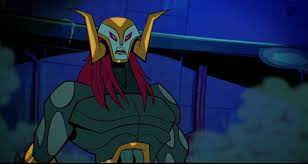
The maniac who wanted to commit genocide on human beings, all because of insufficient proof that they'll do it to his species first?
Didn't we already learn how that's awful reasoning after Steven Universe?
Actually, that's not fair...because Steven Universe has a better explanation behind wanting to redeem the Diamonds than Rise of the Teenage Mutant Ninja Turtles does about Baron Draxum! And I'm not kidding! For Steven Universe, the characters believe that it's better to end things peacefully than killing anyone, even if they're the worst criminals. It's a flawed mentality, sure, but it's one you can grasp and understand. What's the reason for redeeming Baron Draxum? It's because he's the reason why Splinter and the turtles are a family...F**k all the physical torture Splinter went through on top of the social ostracization he experienced because of it. No, no, it totally validates the decision to forgive and forget...Oh, wait, no, it doesn't. BECAUSE THAT WOULD BE INSANE!
Who in the f**k honest to goodness thought that would be a good idea? I'm all for finding silver linings in a bad situation, but that is just flat-out lunacy! Because it's the equivalent of saying, "Yeah, this person was a complete a-hole, but they're still the a-hole that made you who you are today." But that is a very dangerous lesson to preach to kids. Because here's the--Hey *snaps fingers* Here's the thing: If a person treats you like garbage, you don't owe them anything for who you are. It's one thing if a person inspired you or cheered you on, but if someone basically ruined your life and physically harmed you and others, don't forgive them. They don't deserve it. ‘Cause f**k Baron Draxum. And whoever thought this was a good idea, you seriously need some help.
Man, is this how it feels to be Lily Orchard? IT SUCKS!
IN CONCLUSION
And that's what I think about Rise of the Teenage Mutant Ninja Turtles.
It's a fantastic series! I just like everything except for the execution of ideas, most of the characters, and the overall pacing of it...that means it's not a good series, is it?
Yeah, it's a real shame that I don't like this. Because I want to. I really want to. The pieces are there, and I can see how this could be a great and memorable version of a series I loved since I was a tater-tot myself. But I don't. I'm sorry, but I just don't consider this to be an A+ series. It's a solid C, for sure, because it's mostly just style with very little substance. I still respect the amount of effort everyone put into this reboot, but for me, it just never had its chance to fully rise to the occasion.
8 notes
·
View notes
Text
Mastery Reflection - Measuring Design Effectiveness 10.4.3
During this course, we conducted a questionnaire and crafted questions that led to meaningful results about a previous project. This course provided valuable information on how to survey for effective feedback from users. We have to consider what we wanted to know and learn from the target group that would ensure the results of the design will be what is expected and better to solve the client’s design problem.
Website
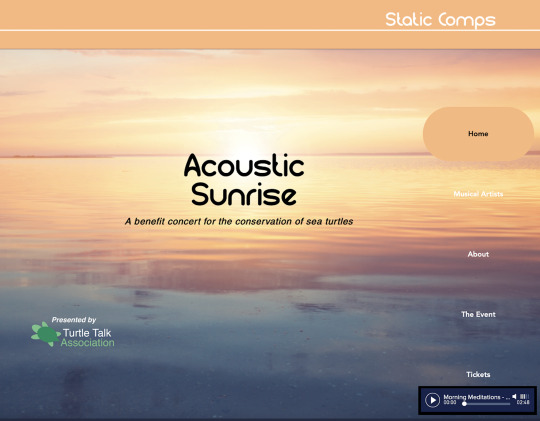
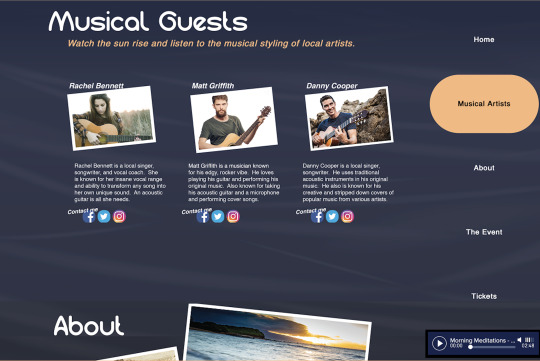
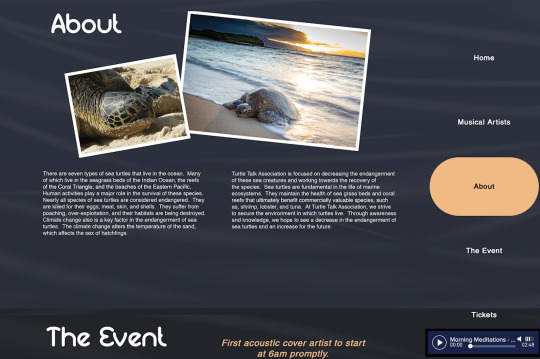
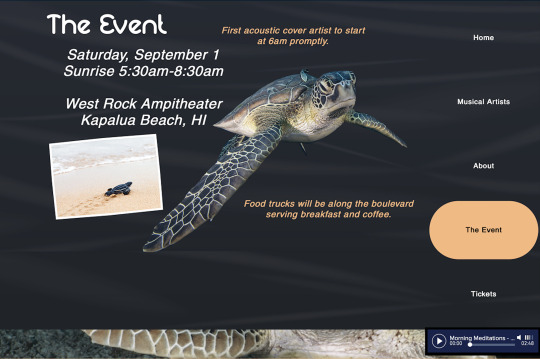


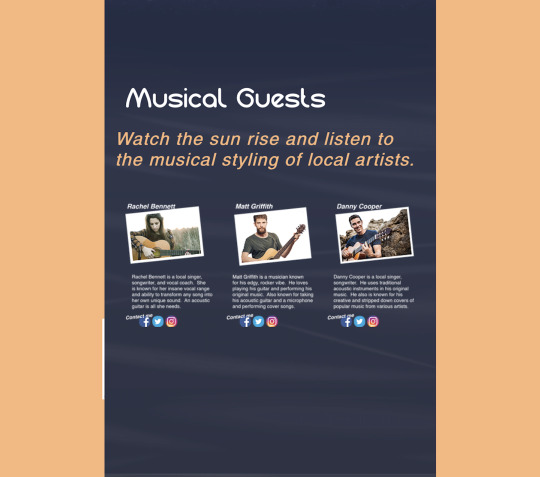
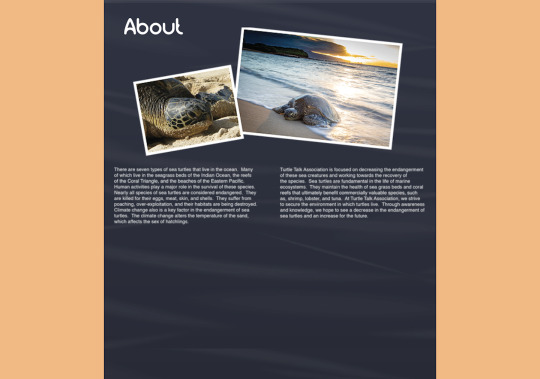
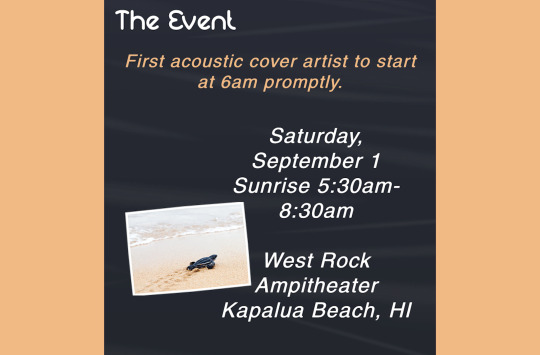
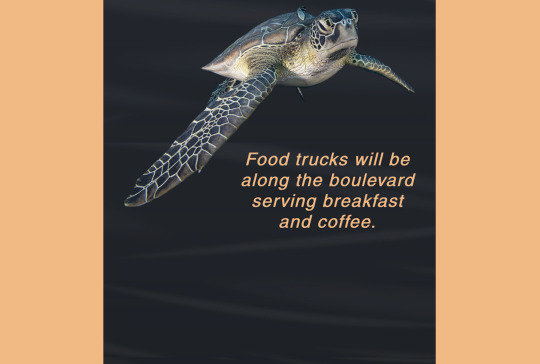

Purpose
The purpose of the project being tested is to create a website for a benefit concert. The design problem is to create an innovative website for the conservation of sea turtles that is user-friendly and persuades the target audience to buy tickets or donate to the cause. The target audience, in this case, is any person of any age that wants to help conserve sea turtles or a person who enjoys live acoustic music. According to Terry Lee Stone,
a particular group declares something as good or bad. And if a person is part of that group, they tend to agree with the group opinion. Why this all matters is that, at its heart, the design is about encoding and decoding messages to move a particular group or target audience to do, think, or feel something (Stone, 2013, Section: 7, Para. 1).
By understanding the target audience and their needs and opinions, a designer will have a better understanding of how to cater to their needs and persuade them to respond to the call to action. By conducting this survey, the designer will better understand these needs.
Initial Questions
What is your gender?
o Male
o Female
o Prefer not to answer
Please specify your ethnicity
o White
o Hispanic or Latino
o Black or African American
o Native American or American Indian
o Asian/Pacific Islander
o Other
What is the highest degree or level of school you have completed? If currently enrolled, the highest degree received.
o High school graduate, GED
o Some college
o Trade/Technical/Vocational Training
o Associate degree
o Bachelor’s degree
o Master’s degree
o Professional degree
o Doctorate degree
What is your marital status?
o Single, never married
o Married, or domestic partnership
o Widowed
o Divorced
o Separated
Are you currently…?
o Employed
o Self-employed
o Homemaker
o Student
o Military
o Retired
o Unable to work
What genre of music do you prefer?
This question will help the designer better understand the type of music the target audience listens to and if the genre of the benefit concert suits their musical taste.
How did you first learn about our website?
The purpose of this question is to help the designer understand where the target audience learned about the event and the website. The target audience will be taking this survey after the launch of the website. Since the website will be launched, the survey is a way to see what the brand can improve on for future events. By understanding this information, the designer will have an idea of where the website and event are promoted and where they should focus and promote more. For example, if the target audience first learns about the event and website through print advertisements, the designer and marketing team should focus more on website banner advertisements or tv commercials. These different media platforms will provide a different demographic of the target audience. In a study by Marketing Artfully, they found that “if you want to target 12 to 24-year olds, you should be using Snapchat and Instagram for your marketing efforts” (Marketing Artfully, 2018, para. 3). As it could be seen, these different platforms are more popular for different demographics and should be used as such.
How likely is it that you could recommend our website to a friend or colleague?
Ed Keller states, “personal recommendations are the number one driver of consumer purchase decisions at every stage in the purchase cycle across 10 product categories studied” (Keller, 2012, para. 3). By asking about recommendations, the marketing team will understand how the target audience responded to the website and whether or not their business will improve based upon word of mouth. Keller also states that “over 8-in-10 purchases influenced by a recommendation are influenced by people talking face-to-face” (Keller, 2012, para. 5). By asking for a face-to-face personal recommendation, the target audience will feel a more personal and human connection to the product or organization.
What comes to your mind when thinking about our website?
What was your first impression when you entered the website?
This is a way to understand the user’s perception of the website. By having them clearly write out their views, then the designer will understand what they think of the website. In an article by James Leist, he discusses how
Your website’s appearance is one of the most important factors in determining how successful it is at converting visitors into customers. When a potential customer visits your website, they make a judgment on whether or not they like the look and feel of it within 0.2 seconds. Typically, the first thing they will look at sits in the top part of the homepage. This will normally include your logo, an image, some headline text, background colors and a navigational bar (Leist, 2017, para.1).
If the designer cannot keep the attention of the visitor with the homepage, they will most likely not move on to visit other pages, therefore the sale is lost. Although this question may come across as vague and may come back with a variety of different responses, the questions offer the audience to respond how they feel fit.
On a scale of 1 to 10 (10 being the highest), What score would you rate us based on user experience?
By getting a score of 1 to 10, the designer will have a better understanding of how successful the website is for the user. Sometimes a numerical number is a faster and better way to understand the success rate rather than a written explanation.
How does our website compare to other event websites?
This question helps the designer investigate the strengths and weaknesses of the website design and usability. It also addresses the competition, which is a good way to see what others are using for their designs as a way to gain more ideas for the future. It is very important to stay up to date with the latest trends and keep up with the competition.
What do you like least about our website?
What do you like most about our website?
Which feature(s) of our website are most important to you?
Which feature(s) of our website are least important to you?
These sets of questions help to understand what elements of the website makes the user happy or sad, as well as what features the user likes or dislikes. It is unfair to add new features to the website without improving the ones already in existence. These questions pinpoint what works and what does not. Kathryn Best states, “different ways that design success can be measured include… improved product and service quality” (Best, 2006, pg. 173). By improving the quality of the product, the user is more likely to respond to the call of action, resulting in a larger design success rate.
How easy is our website to use?
The user is the most important person the designer must keep in mind. If the website is not easy to use, the website will most likely fail, and the event will not sell tickets. “Responses can be used to determine whether users are satisfied with or confused by the new tools” (Visocky O’Grady, 2009, pg. 28). The usability of the website determines whether or not the visitor continues to scroll through the website and ultimately whether or not they buy tickets or donate.
What is the most important feature(s) you think we should add to our website?
This question helps to inform the designer of the weaknesses and shortcomings of the website design. By asking the user what they want to see on the website, it gives them a deeper connection to the website and makes them feel important and like their ideas matter. Hilary Collins believes, “questionnaires allow plenty of time for the respondent to formulate their responses and also avoid any interviewer bias” (Collins, 2010, pg. 128). These questions allow the user to give their true opinion without being persuaded by an interviewer.
Would the website move you buy tickets or donate to the organization?
This question helps the designer know whether or not the usability and design of the website actually worked and persuaded the user to respond to the call to action. This is a way to optimize sales and increase revenue. Again, the survey will be taken after launch and after the user has visited the website. If the user was not moved buy tickets, what stopped them and how can the website be improved to change their response to the websites call to action.
If so, what is your preferred payment/delivery method?
Did we offer this type of method?
By asking this question the designer can understand what payment method is the most popular and easiest for their visitors. Everything could be perfect about the website, but if they do not offer the payment method easiest for the user, then the sale may have just been lost. If we do not offer the most up to date payment method, then this is something the designer should look into and maybe add for the future.
Was pricing reasonable and clear to you?
Again, this goes back to usability. If navigation and how to purchase tickets is unclear to the user, then the tickets may not have been sold and a customer has been lost.
Is there anything missing from this website?
If you were unhappy with us, what can we do to improve your experience in the future?
These last two questions are here to improve the website design in the future. It gives the visitor the opportunity to give us constructive feedback on how to improve the website. If information or features are missing from the design, this allows them to tell us what these are and why they would like these added. It is impossible to make every customer fully satisfied, so by giving them the opportunity to give feedback, it helps the designer know what information, design elements, or features should not be missed.
Peer Review and Revisions
After receiving peer review and feedback from the instructor, it was determined that some questions should be reworded and that they should not all be open-ended. By adding multiple choices, the survey will be more likely to be completed in full with no questions skipped. Survey Monkey only allows for 10 questions, so I had to narrow down to the best questions that I felt would provide the best results and the most constructive feedback. Although I would have loved to include questions about the demographics of the target audience, I had to eliminate these questions in order to have the most questions about the work itself. The final survey questions were as follows:
1. How likely is it that you would recommend our website to a friend or colleague?
2. What was your first impression when you entered the website? How did you hear about us?
3. On a scale of 1 to 10 (10 being the highest), what score would you rate us based on user experience?
4. What do you like least/most about our website?
5. How easy is our website to use?
6. Would the website move you to buy tickets or donate to the organization?
7. What is your preferred payment/delivery method?
8. Was pricing reasonable and clear to you?
9. Is there anything missing from the website?
10. If you were unhappy with us, what can we do to improve your experience in the future?
Results
After viewing the responses on the last day of the survey is open, I found that there were only about 13 responses. This was not as many as I had anticipated, so on break at work, I asked everyone I could in the break room to come take the survey on my laptop, which added another 15 responses for a total of 28 responses, which is a better total to get a clear analysis of the results.
On average, a respondent took about 2 minutes and 19 seconds to complete the survey. The following will be a question by question breakdown of the responses.
1. How likely is it that you would recommend our website to a friend or colleague?
53.57% said very likely
35.71% said likely
10.71% said neither likely or unlikely
Recommendations and word of mouth are very important when it comes to websites because it allows for more traffic through the site and the potential for more donations or sales. Hitesh Bhasin states,
Quite simply said, if the right positive review hits the right chord with the prospect, then he can be converted to a customer just because of the correct customer review that he read. You see a lot of people buying products online just because they saw five stars and read some great comments in the reviews section (Bhasin, 2018, para. 5).
2. What was your first impression when you entered the website? How did you hear about us?
While writing these open-ended questions, I knew they would produce a wide variety of answers. However, this was not the case after looking back at the responses. One of the main responses was that their first impression of the website was that it was very clean cut and simple. Many people loved the colors and pictures. One person loved the cause, so the sea turtles were the first thing they saw. Another person loved the vertical navigation bar on the right-hand side. They said that this type of navigation bar is not seen very much, so it was one of the first things that they saw. All of the responses were very positive, which is helpful because it shows that the design was simplistic to not overwhelm, but was visually appealing enough to keep them drawn in.
3. On a scale of 1 to 10 (10 being the highest), what score would you rate us based on user experience?
The average of all responses was an 8.6. Anything about an 8 to me is very good. This means that the user has a positive experience and found the website to be easy to use and were able to find what they were looking for.
4. What do you like least/most about our website?
Again, with an open-ended response, I assumed that there would be a bunch of different responses. What people liked the most about the website is the simplicity, theming and how easy it was to navigate (especially with the sidebar). They also loved the pictures and the font styles. The one-page scrolling made all of the information accessible without having to flip through different pages. Although they loved the simplicity, they also found that there could be more information on the artists. I definitely could agree with them. The musical guests’ descriptions are very vague, but since all of that information is made up, it was difficult to come up with information. However, this is good to know that users want to know more about the artists and do not mind more words on the page. The most consistent dislike was the music bar at the bottom of the page. Some people found the color or the fact that it was stationary distracting. I could agree with this and is something that I struggled with while creating the website. I was going to get rid of the music bar altogether but kept it because I wanted a fully immersive website. Moving forward maybe having the sidebar be a cheeseburger menu and having the music bar be part of that would be more beneficial.
5. How easy is our website to use?
71.43% said very easy
28.57% said easy
This is probably the most important question in the entire survey. Angela De Schrijver writes, “according to statistics gathered by the Website Standards Association, visitors will remain on a Web page for about 10 seconds before deciding to leave or stay” (De Schrijver, 2017). Since a user knows almost immediately whether or not they want to continue scrolling through a website, how easy it is to navigate through is very important in maintaining their interest and not overwhelming them or making them frustrated.
6. Would the website move you to buy tickets or donate to the organization?
82.14% said yes
7.14% said no
10.71% said neither yes or no
The majority of people said yes, which is helpful in knowing that the website is persuasive enough to engage the audience as well as move them to respond to the call to action in a positive way.
7. What is your preferred payment/delivery method?
The answers to this question did not come as a surprise. I had a feeling almost everyone would say by card and would like their tickets e-mailed or electronically sent to them. Some people responded with Venmo, PayPal, or Apple Pay, which are all ways that I did not think of. These options are very helpful in the future.
8. Was pricing reasonable and clear to you?
96.43% said yes
3.57% said no
Almost every response said yes. For marketing purposes, ticket prices should be clear and reasonable for the consumer, but also take in a profit for the organization. The price should not come as a shock to the guest, so the fact that the price was fair and clear to the guest is very helpful for future events.
9. Is there anything missing from the website?
The following two questions, I anticipated no answers, however, the responses were very helpful. The majority of responses said that there should be a direct link to donate, which is something that I did not even think of. Other responses were more information on sea turtles, the cause, and the artists, which is good to know for the future. One person said that there were no popups. I always assumed that users disliked popups, so maybe this is something to look into.
10. If you were unhappy with us, what can we do to improve your experience in the future?
As stated above, I did not expect many answers to this question. Most people said that they were happy and satisfied with their experience. The responses that went further in detail stated that there could maybe be another page for future events or that the social media icons were a little distracting. Moving forward maybe the social media icons could all be changed to one color that is within the color scheme, that way they will not distract from the other information on the page.
Conclusion
Altogether, I found that the results of the survey were very helpful. Web design was always something I struggled with during my undergrad, so by conducting this survey and receiving positive reviews was a great learning experience. I found that people do not mind reading more information and that simplicity is the way to go. The bold colors were something that stood out to people, but when introducing a secondary color such as with the music bar or the social media icons, they were not received as positively. Respondents came up with aspects of the website that I did not think about, such as a donations box or a tab that led to more future events. Overall, I am very satisfied with my results and know what to improve on for future projects.
This course was very helpful in evaluating and analyzing the results from a survey or questionnaire about user experience. When it came to the mastery paper, it was helpful to write out the design process and see how research, prototyping, iterating designs, and coming up with solutions to the design problem works to help the client. Moving forward, I feel a lot better about creating websites and knowing what the user likes and dislikes.
References
Best, K. (2006, October 31). Design Management. Retrieved January 13, 2019, from https://ce.safaribooksonline.com/book/design/9782940439782
Bhasin, H. (2018, February 12). Importance of Customer reviews and recommendations to businesses. Retrieved January 27, 2019, from https://www.marketing91.com/customer-reviews-and-recommendations/
Collins, H. (2010, September 01). Creative Research. Retrieved January 13, 2019, from https://ce.safaribooksonline.com/book/design/9782940439676
Jacobsen, T. (2018, December 29). Customer Demographics - Age Demographics for Advertising (Updated 2018). Retrieved January 13, 2019, from https://marketingartfully.com/2012/12/13/customer-demographics-age-demographics-for-advertising/
Keller, E. (2012, July 27). Recommendations are What Drives Your Business. Remember to Ask for them. Retrieved January 13, 2019, from https://www.forbes.com/sites/kellerfaygroup/2012/07/25/recommendations-are-what-drives-your-business-remember-to-ask-for-them/#4ff4372439c6
Leist, J. (2017, February 4). The Importance of Website First Impressions. Retrieved January 13, 2019, from http://jamesleist.com/above-the-fold-the-importance-of-website-first-impressions/
Schrijver, A. D. (2017, November 21). Importance of Web Usability. Retrieved January 27, 2019, from https://smallbusiness.chron.com/importance-usability-44946.html
Stone, T. (2013, September 12). Evaluating design based on a creative brief. Retrieved January 13, 2019, from https://www.lynda.com/Design-Business-tutorials/Evaluating-design-based-creative-brief/114320/148463-4.html?org=fullsail.edu
Trista. (2018, April 04). 20 User Experience Survey Questions and Templates for Inspiration. Retrieved January 13, 2019, from https://www.mockplus.com/blog/post/user-experience-survey-questions
0 notes